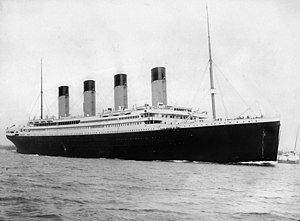RMS Titanic was a British passenger liner that sank in the North Atlantic Ocean in the early morning of 15 April 1912, after colliding with an iceberg during her maiden voyage from Southampton, UK, to New York City, US. The sinking resulted in the deaths of more than 1,500 passengers and crew, making it one of the deadliest commercial peacetime maritime disasters in modern history. The RMS Titanic, the largest ship afloat at the time it entered service, was the second of three Olympic class ocean liners operated by the White Star Line, and was built by the Harland and Wolff shipyard in Belfast, with Thomas Andrews as her naval architect. Andrews was among those who died in the sinking. On her maiden voyage, she carried 2,224 passengers and crew.
Титаник (RMS Titanic) е един от трите британски океански лайнера от клас „Олимпик“ (заедно с Олимпик и Британик), известен със сблъсъка си с айсберг и трагичното си потъване на 15 април 1912 г. Построен в корабостроителницата Harland and Wolff в Белфаст, „Титаник“ е най-големият пътнически параход в света по онова време. Съкращението RMS в наименованието му означава Royal Mail Ship („Кралски пощенски кораб“) и се е поставяло пред имената на кораби, можещи да пренасят пощенски пратки по договор с британската държавна пощенска служба Royal Mail . По време на първото си плаване от Саутхемптън (Англия), Шербур (Франция), Куинстаун (Ирландия) и Ню Йорк, той се сблъсква с айсберг в 23:40 часа вечерта на 14 април 1912 г. (неделя) и потъва два часа и четиридесет минути по-късно – в 2:20 часа сутринта на 15 април 1912 г. (понеделник), след като се разцепва на две части.Under the command of Edward Smith, the ship carried some of the wealthiest people in the world, as well as hundreds of emigrants from Great Britain and Ireland, Scandinavia and elsewhere throughout Europe seeking a new life in North America. A high-power radiotelegraph transmitter was available for sending passenger "marconigrams" and for the ship's operational use. Although Titanic had advanced safety features such as watertight compartments and remotely activated watertight doors, there were not enough lifeboats to accommodate all of those aboard due to outdated maritime safety regulations. Titanic only carried enough lifeboats for 1,178 people—slightly more than half of the number on board, and one third of her total capacity. After leaving Southampton on 10 April 1912, Titanic called at Cherbourg in France and Queenstown (now Cobh) in Ireland before heading west to New York.[2] On 14 April 1912, four days into the crossing and about 375 miles (600 km) south of Newfoundland, she hit an iceberg at 11:40 p.m. ship's time. The collision caused the ship's hull plates to buckle inwards along her starboard side and opened five of her sixteen watertight compartments to the sea; the ship gradually filled with water. Meanwhile, passengers and some crew members were evacuated in lifeboats, many of which were launched only partly loaded. A disproportionate number of men were left aboard because of a "women and children first" protocol followed by some of the officers loading the lifeboats.[3] By 2:20 a.m., she broke apart and foundered, with well over one thousand people still aboard. Just under two hours after Titanic foundered, the Cunard liner RMS Carpathia arrived on the scene of the sinking, where she brought aboard an estimated 705 survivors. The disaster was greeted with worldwide shock and outrage at the huge loss of life and the regulatory and operational failures that had led to it. Public inquiries in Britain and the United States led to major improvements in maritime safety. One of their most important legacies was the establishment in 1914 of the International Convention for the Safety of Life at Sea (SOLAS), which still governs maritime safety today. Additionally, several new wireless regulations were passed around the world in an effort to learn from the many missteps in wireless communications—which could have saved many more passengers.[4] The wreck of Titanic remains on the seabed, split in two and gradually disintegrating at a depth of 12,415 feet (3,784 m). Since her discovery in 1985, thousands of artefacts have been recovered and put on display at museums around the world. Titanic has become one of the most famous ships in history; her memory is kept alive by numerous works of popular culture, including books, folk songs, films, exhibits, and memorials. From Wikipedia, the free encyclopedia

